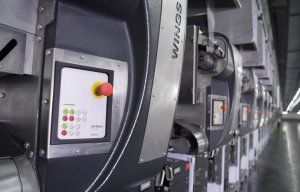
Indian spinner uses WINGS to make rPET FDY
Oerlikon Barmag is one of only two known companies that deliver machine solutions for the production of HMLS yarn.

4th May 2015
Innovation in Textiles
|
Remscheid/Frankfurt
Oerlikon Barmag is one of only two known companies that deliver machine solutions for the production of HMLS yarn, according to the manufacturer.
The material is said to be extremely tear resistant, but elastic, and temperature, as well as dimensionally stable. It is predominantly used in high-speed tires, which are subjected to particularly high loads as a result of the high speeds achieved. Here, strong polyester tire cord has almost completely replaced viscose fibre rayon for ecological reasons.
As a result of contact with the road, tires are subjected to a constant friction, which heats up the tires and consequently increases the internal air pressure.
Therefore, the higher the speed, the higher is the tire temperature and the pressure within the tire. And this is precisely where high-modulus polyester comes into its own: reinforcing tires with dimensionally-stable HMLS is also said to allow high speeds with a high degree of safety.
In other words, tires made from HMLS yarn remain dimensionally stable even under loads and at high temperatures.
The HMLS yarn acquires its unique properties in the spinning process. High speeds in the production process are said to guarantee a stable arrangement of the molecules within the polymer, which forms the actual filament. The internal structure of the molecule chain is in turn decisive for the dimensional stability of the subsequent yarn.
Manufacturing this challenging material in an economical manner requires stable process technology and high-quality components. These determine the requirements for the spinning plant, the godets and the winders.
The higher the spinning and winding speeds, the more sensitively the filaments react to even the smallest irregularities in the polymer melt, which can then quickly result in breaks in the filament. Oerlikon Barmag HMLS systems therefore now work with the EvoQuench quenching system to balance out the unavoidable contamination in the melt. Filament bundles with up to 600 individual filaments are evenly spun, cooled and spin-finished and in this way allow homogenous threads of between 1000 and 2000 denier to be manufactured.
Using the EvoQuench system for manufacturing industrial yarn is also energy efficient. As in the case of textile processes, the e-save certified EvoQuench system dramatically lowers the energy consumption, the company reports.
Depending on the titer and the dpf, the consumption of the compressed air so decisive for the energy consumption in quenching is reduced by around 80% compared to a cross-flow quenching system.
As a result, due to the considerably lower air consumption, the air-conditioning systems can be correspondingly smaller in scale, which in turn reduces investment costs for air-conditioning by 80%, according to the manufacturer.

Business intelligence for the fibre, textiles and apparel industries: technologies, innovations, markets, investments, trade policy, sourcing, strategy...
Find out more